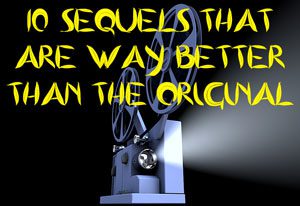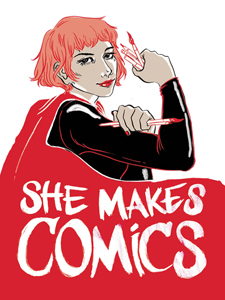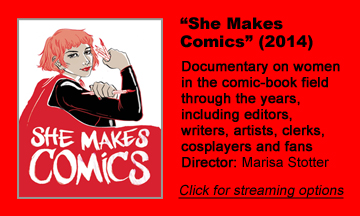“She Makes Comics” (2014) is invaluable simply for its existence. Although it juggles a bevy of comics-related topics and raises more questions than it answers, director Marisa Stotter’s documentary illuminates women in the industry like never before, putting faces to famous names.
Driven by interviews with dozens of key women in comics — along with historians, fans and comic-shop clerks – the 70-minute film leaves an overwhelming impression that women have – and always have had – an important place in the field.
A schizophrenic message
But it’s a schizophrenic documentary because it also makes a case that women have been marginalized. At one particularly funny point, “She Makes Comics” breaks out of the talking-heads format and shows a re-enactment of a stereotypical scene of a woman entering a comic shop and being gawked at by the clerk and patrons. This scenario isn’t invented from whole cloth, as I know from my comic-shop-visiting days.
In another humorous segment, someone points out that know-it-alls (men who demand that women know everything about a character in order to be allowed to like that character) drive some women out of the hobby.
The interviewees are perhaps too short on sympathy toward socially awkward men (a common type in fandom). And Stotter misses a chance to examine the different ways men and women consume comics: Men are more likely to become obsessed with minutiae, and women are more likely to appreciate comics in a different way.
The documentary very briefly points out that Wendy Pini’s “Elfquest” and Neil Gaiman’s “Sandman” are hugely popular among female readers, with one interviewee calling the latter the “weed” of comics; it’s what got her hooked. What is different about women compared to men that draws them to those brands of fantasy?
In another too-quick segment, Chris Claremont – writer of the “X-Men” “Dark Phoenix” arc from the 1980s – shoots the breeze with his editors, Ann Nocenti and Louise Simonson (names I knew from Marvel’s “Star Wars” comics of that era). He says their input was crucial, but we don’t learn anything more than that. Again, Stotter presents the reality but goes no deeper.
Meeting the women in comics
The highlight of “She Makes Comics” is meeting the women who make comics. There are only a few men interviewed for this documentary, but I’m fine with that. Since the film loves both gals-in-comics and comics themselves, guys are unlikely to feel threatened by the parade of women who have achieved a spot in the industry, whether it’s:
- 1970s cosplay pioneer and later “Elfquest” writer Pini;
- 1980s DC Comics publisher Karen Berger;
- Becky Cloonan, the first woman to draw Batman in the main title (something that happened shockingly recently);
- or modern comic-writing superstar Kelly Sue DeConnick (“Captain Marvel”).
This medium is clearly big enough for everyone.
Yet seeing this plethora of women of all ages and interests in the field, “She Makes Comics” undercuts the theory that the gender is marginalized. This isn’t necessarily a misstep, because the explanation could be that there have been ebbs and flows through the years.

An odd dichotomy
More girls than boys read superhero comics in the 1950s, and women-focused stories were told in the four-color pages during World War II (as they took over jobs from men who were off to war) and in underground circles amid the Comics Code Authority backlash.
Yet early comic conventions had about a 95-to-5 male-to-female split, historians say. One of the reasons for women feeling gawked at in comic shops is that men don’t see many of them there.
Stotter and her team don’t attempt to reconcile this odd dichotomy by clearing up the timeline of events. Or perhaps women have always had a significant presence but have been overlooked by John and Jane Q. Public and journalists and historians covering the industry.
The creators of the most famous superheroes are men, so perhaps that skews the public’s consciousness. (Even “Wonder Woman” was created by a man, William Moulton Marston, although he was heavily influenced by the two women in his life. This film skims over “WW,” but I’m OK with that, as that story has been well-covered elsewhere.)
Beyond making a solid case that comics are for everyone, this documentary doesn’t have a crystal-clear point, and it breezes past fascinating questions without realizing it raised them. Still, “She Makes Comics” is a platform for women’s voices, and it’s great to see them and hear from them.


